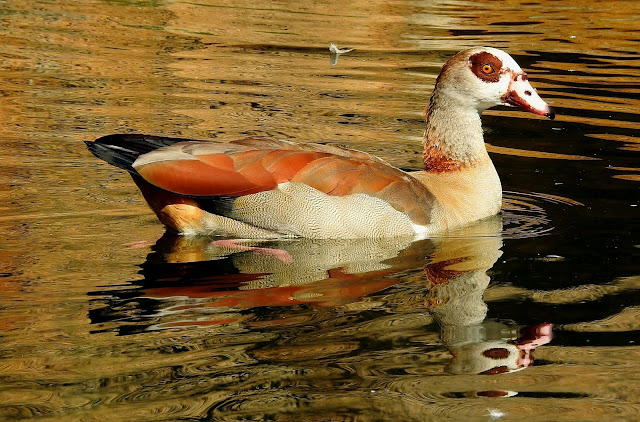The Egyptian goose (Alopochen aegyptiaca) is an African member of the Anatidae family including ducks, geese, and swans. Because of their popularity chiefly as an ornamental bird, the species has also been introduced to Europe, the United States and elsewhere outside their natural range. Egyptian geese were regularly represented in ancient Egyptian art.
The Egyptian goose is believed to be most closely related to the shelducks (genus Tadorna) and their relatives, and is placed with them in the subfamily Tadorninae. It is the only extant member of the genus Alopochen, which also contains closely related prehistoric and recently extinct species. mtDNA cytochrome b sequence data suggest that the relationships of Alopochen to Tadorna need further investigation.
It swims well and appears heavy in flight, more like a goose than a duck, hence the English name. On average, they are 63–73 cm (25–29 in) tall.
The sexes of this species are identical in plumage but the males are usually somewhat larger. They vary greatly in plumage tone, with some birds greyer and others browner, but this variation has not been observed to be sex- or age-related. A large part of the wings of mature birds is white, but the white is hidden by the wing coverts when at rest. When it is aroused, either in alarm or aggression, the white is displayed.
Egyptian geese in the wild can live for up to 15 years, while captive individuals have been recorded reaching an age of 35.
The voices and vocalisations of the sexes differ, the male having a hoarse, subdued duck-like quack which seldom sounds unless it is aroused, as well as a louder, breathy call which is performed in a rapid sequence, sounding somewhat like a steam engine. The female has a far noisier raucous quack that frequently sounds in aggression when tending her young. The male Egyptian goose attracts its mate with an elaborate, noisy courtship display that includes honking, neck stretching and feather displays.
The Egyptian goose is native to Sub-Saharan Africa and the Nile Valley, where it is widespread and common to abundant, though it has become scarce in the northern Nile Valley. It is found in open or semi-open habitats, typically near fresh water, ranging from lowlands to 4,000 m (13,000 ft) above sea level in the Ethiopian Highlands, and largely absent from dense forests and deserts. While not breeding, it disperses somewhat, sometimes making longer migrations northwards into the arid regions of the Sahel, and occasionally even reaching the North African nations of Algeria and Tunisia, historically a more frequent part of its range.
It was found in southeastern Europe (up to the lower Danube Valley and southern Hungary) until the early 1700s, and in parts of Turkey and the western Middle East until the early 1900s (and has since re-established through escaped captives), but its historical ranges in these places is incompletely known and the reason for the disappearances is also unknown.
This is a largely terrestrial species, which will also perch on trees and buildings.
This species will nest in a large variety of situations, especially in holes in mature trees in parkland. The female builds the nest from reeds, leaves and grass and both parents take turns incubating the eggs. Egyptian geese usually mate for life. Both the male and female care for the offspring until they are old enough to care for themselves. Such parental care, however, does not include foraging for the young, which are able forage for themselves upon hatching.
Egyptian geese typically eat seeds, leaves, grasses and plant stems. Occasionally, they will eat locusts, worms, or other small animals. Until the goslings are a few weeks old and strong enough to graze, they feed largely on small aquatic invertebrates, especially freshwater plankton. As a result, if anoxic conditions lead to the production of botulinum toxin and it gets passed up the food chain via worms and insect larvae insensitive to the toxin, entire clutches of goslings feeding on such prey may die. The parents, who do not eat such organisms to any significant extent, generally remain unaffected.
Both sexes are aggressively territorial towards their own species when breeding and frequently pursue intruders into the air, attacking them in aerial "dogfights". Egyptian geese have been observed attacking aerial objects such as drones that enter their habitat as well. Neighbouring pairs may even kill another's offspring for their own offsprings' survival, as well as for more resources.
In their native range, predators of Egyptian geese include leopards, lions, cheetahs, hyenas, crocodiles and Old World vultures.



